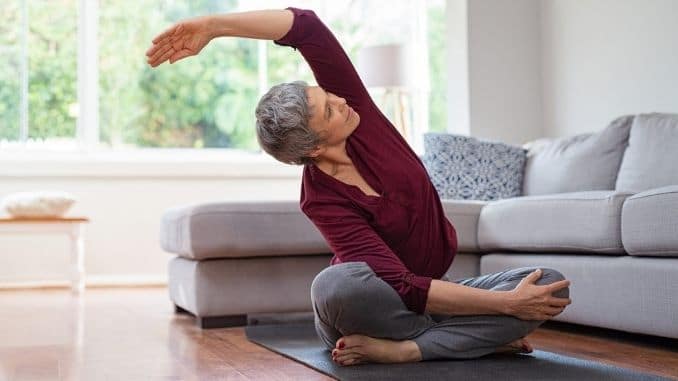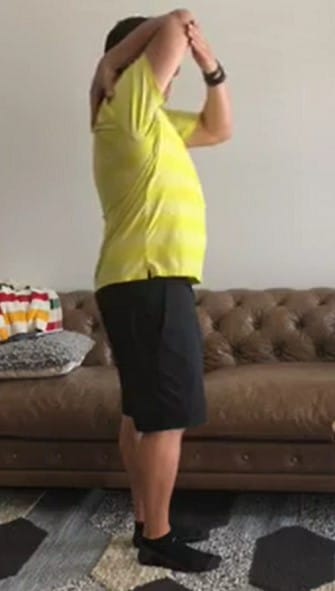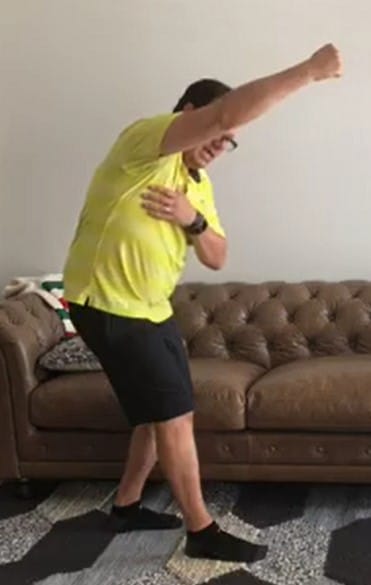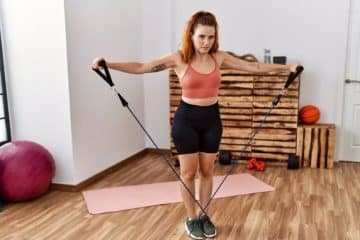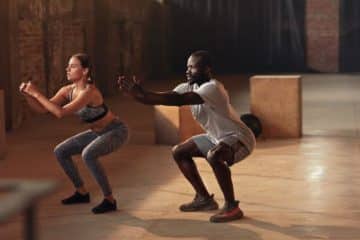Basically, exercise can have a very positive impact on fibromyalgia. The vicious cycle of fibromyalgia involves pain, decreased mobility, being further deconditioned, and feeling stuck in a vortex of pain.
Exercise, like aerobics, strength training, and stretching, can help break this cycle. Proper nutrition, hydration, increasing social support, and decreasing stress levels can also have a big effect on fibromyalgia.
Moreover, stretching and resistance training are both very impactful for fibromyalgia sufferers. Stretching helps improve quality of life by improving mobility and decreasing pain.
Moreover, stretching is one of the most common recommendations given to people with fibromyalg.
Give the exercises below a try. Start with 1 set of 3 repetitions, ideally holding for 30 seconds, and progress to 4-5 repetitions.
These exercises target the larger muscle groups.
1. Chest Stretch
Firstly, begin in an upright standing position, maintaining good alignment with your head, shoulders, hips, and legs. Looking for a light stretch in front of the chest, pull your shoulder blades back.
Hold this position for 30 seconds. Return to the starting position and then repeat the movement.

Progression Exercise:
Firstly, begin in an upright standing position, maintaining good alignment with your head, shoulders, and hips. Interlace your fingers behind your back.
Engage your core and lift your joined hands away from your body.
Hold this position for 30 seconds for stretches for fibromyalgia. Slowly return to the starting position and then repeat the movement.

Progression Exercise:
Begin in an upright standing position beside a wall or doorway, maintaining good alignment with your head, shoulders, hips, and legs. Press one arm up against the wall, keeping your elbow slightly below shoulder height, as part of stretches for fibromyalgia.
Looking for a stretch in the front of the shoulder and chest, engage your core and take one step forward with the foot closest to the wall.
Turn away from your shoulder to intensify the stretch after that, hold this position for 30 seconds. Return to the starting position and then repeat the movement on the opposite side.
2. Tricep Stretch
Begin in an upright standing position, maintaining good alignment with your head, shoulders, hips, and legs. Lift one arm overhead, then bend your elbow to lower your hand behind your head.
Use your other hand to slowly push your elbow further back, intensifying the stretch.
After that, hold this position for 30 seconds. Return to the starting position and then repeat the movement on the opposite side.
3. Lats Stretch
Basically, begin in an upright standing position, maintaining good alignment with your head, shoulders, hips, and legs.
Cross your arms over your chest. Engage your core and bend your upper body slightly forward and over to one side.
After that, hold this position for 30 seconds. Return to the starting position and then repeat the movement on the opposite side.

Progression Exercise:
Begin in an upright standing position, maintaining good alignment with your head, shoulders, hips, and legs. Cross one arm over your chest and reach overhead with your opposite arm.
After that, engage your core and bend your upper body to the side for stretches for fibromyalgia.
Hold this position for 30 seconds. Return to the starting position and then repeat the movement on the opposite side.
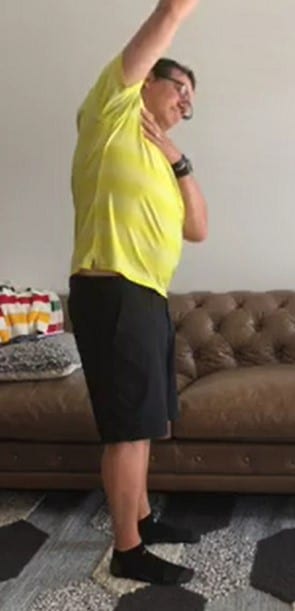
Progression Exercise:
Basically, begin in an upright standing position, maintaining good alignment with your head, shoulders, hips, and legs. Hold onto the doorframe with one hand and lean back, holding this position for 30 seconds.
Return to the starting position and then repeat the movement on the opposite side.
4. Knee to Shoulder
Begin in an upright sitting position with your feet shoulder-width apart, maintaining good alignment with your head, shoulders, and hips. Lift one knee.
After that, pull your knee closer to your body to intensify the stretch.
Hold this position for 30 seconds. Relax and lower your leg to return to the starting position and then repeat the movement on the opposite side.
5. Knee to Opposite Shoulder
Begin in an upright sitting position with your feet shoulder-width apart, maintaining good alignment with your head, shoulders, and hips. Lift one knee towards the opposite shoulder side.
Pull your knee closer to your body to intensify the stretch.
Hold this position for 30 seconds. Relax and then lower your leg to return to the starting. Repeat the movement on the opposite side.

🌟 Find Migraine Relief Through Yoga! 🌟
Are migraines disrupting your life? Discover the power of gentle yoga to alleviate your discomfort. Our guide, “10 Gentle Yoga Poses for Migraine Relief,” offers simple yet effective poses to help you find peace and pain relief.
✨ Embrace Natural Healing 🧘♀️ Easy-to-Follow Instructions 💆♂️ Suitable for All Levels
Start your journey to a migraine-free life today! Click the link below to explore the poses and reclaim your well-being.

